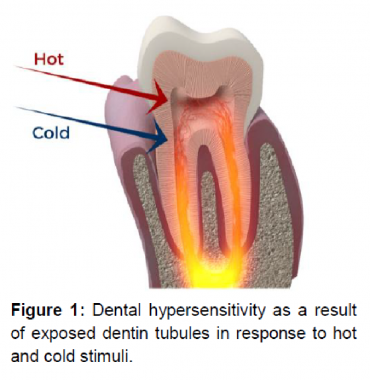Dentine hypersensitivity is considered to be the most common dental problems encountered by dentists in their routine clinical practice. It is one of the most painful and least successfully treated chronic dental problems. Evidence suggests that about 8-30% of adults are affected by dentine hypersensitivity and the adults between 20 to 40 years of age are affected the most. Abrasion, attrition, erosion, abfraction, gingival recession and improper brushing are the causes of dentine hypersensitivity.


Dentine hypersensitivity is brought about by the action of food, drinks and hot and cold temperatures that expose the dentine and underlying nerves to the stimuli (Fig.1).2
Various theories explain the mechanism of hypersensitivity including direct stimulation theory, odontoblastic transducer mechanism, gate control theory, and the hydrodynamic theory. The hydrodynamic theory is the most accepted theory which states that rapid shift in the fluid flow within the dentinal tubules appears to be responsible for causing odontoblastic pain.1
Management of Dentinal Hypersensitivity
Dentine hypersensitivity can be managed by a wide variety of procedures, agents and formulations which are applied either ‘in office’ or ‘at home’. There are two main desensitizing techniques are used in the treatment of dentine hypersensitivity:3
- Desensitizing by occluding the dentinal tubules by formation of smear layer on the exposed area. The agents used in this technique are calcium hydroxide, hydroxyapatite, silver nitrate, strontium chloride, by means of using hard tissue lasers or fluoride iontophoresis
- Desensitizing by blocking the pulpal sensory nerves with agents like silver nitrate in various forms.
In-office desensitizing agents
The in-office desensitizing therapy provides an immediate relief from dentine hypersensitivity. In-office desensitizing agents include glass ionomer cement, composites, varnishes, oxalates etc.
At home desensitizing agents
The requirements for an ideal dentine desensitizing agent have been listed by Grossman which includes:
- Rapidly acting with long-term effects
- Non-irritant to pulp
- Painless and easy to apply
- Should not stain the tooth
The traditional therapy for the management of dentine hypersensitivity is primarily aimed at occluding the dentinal tubules or making coagulates inside the tubules. Patients are frequently prescribed with over-the counter desensitising agents. At home desensitizing agents include toothpastes, mouthwashes and chewing gums.4
Desensitizing toothpaste
Many desensitizing toothpastes contain potassium salts, sodium fluoride, strontium chloride, dibasic sodium citrate, formaldehyde, sodium monofluorphosphate and stannous fluoride. The desensitising toothpastes should be used with toothbrush with soft bristles. Patients are advised to use less water to avoid dilution of the active ingredient.4
Desensitizing toothpastes are most widely used home treatment for the management of dentine hypersensitivity. Nano-technology has been advancing; nano-particles of hydroxyapatite are incorporated in dentifrices which occlude the dentinal tubules by its smaller particle size.3
Efficacy of Nano-hydroxyapatite in the management of dentine hypersensitivity
Reddy S et al, conducted a study to assess the efficacy of pro-argin technology and nano technology in the management of dentine hypersensitivity.5
The study was conducted in 30 patients with at least 2 sensitive teeth with a verbal rating scale (VRS) of >5 post air blast stimulation. The patients were divided into 2 groups Group 1 received toothpaste with pro-argin technology and Group 2 received toothpaste with nano-hydroxyapatite technology. These patients were subjected to cold water and air blast stimulation for dentine hypersensitivity assessment at baseline and after 3 days using VRS scores.5
The study results demonstrated that there was a significant rapid relief in patients using toothpaste with nano-hydroxyapatite.5
An in vitrostudy was conducted to compare the dentifrice with nano-hydroxyapatite (Aclaim) versus pro-argin technology. The study showed that nano-hydroxyapatite containing dentifrice led to a high degree of tubule occlusion after just 2 minutes and was five times faster than the occlusion rate observed in pro-argin technology (Fig 2).2

An in vivo clinical study was conducted involving 45 patients to evaluate the efficacy of toothpaste containing nano-hydroxyapatite (Aclaim), potassium nitrate and propolis in management of dentine hypersensitivity. Propolis is a natural, non-toxic resin which can occlude dentin tubules and decreases their permeability, while potassium nitrate reduces dentinal sensory activity. Patient’s dentine hypersensitivity was tested using visual analogscale for pain before and after using the dentifrices. Figure 3 shows the results after one and four weeks of treatment.2


Fig. 3 Reduction of dental hypersensitivity after treatment with potassium nitrate, Propolis and Aclaim during one and four weeks.
Nithin G et al, conducted a randomized, double-blind, parallel arm study to assess and compare the effectiveness between nano-hydroxyapatite and a benchmark dentifrice in reducing dentine hypersensitivity.
The study included 36 patients who were randomly assigned with two dentifrices group 1 with nano-hydroxyapatite (Aclaim) and Group 2 with 5% calcium sodium phosphosilicate. The patients were evaluated clinically using three different stimuli including tactile, cold water and air blast. The patients’ response was evaluated at baseline and after 4 weeks.The toothpaste containing hydroxyapatite was effective in reducing dentine hypersensitivity and hence can be recommended in the management of hypersensitivity.6
Conclusion
Dentine hypersensitivity is considered to be the most common dental problems encountered by dentists in their routine clinical practice. It is one of the most painful and least successfully treated chronic dental problems.1Dentine hypersensitivity can be managed by a wide variety of procedures, agents and formulations which are applied either ‘in office’ or ‘at home’.Desensitizing toothpastes are most widely used home treatment for the management of dentine hypersensitivity. Nano-technology has been advancing; nano-particles of hydroxyapatite are incorporated in dentifrices which occlude the dentinal tubules by its smaller particle size.3 Evidence suggests that toothpastes containing nano-hydroxyapatite are effective at occluding dentin tubules and reducing dentine hypersensitivity.2
References
- Nithin G, John J, Nagappan N, Prabhu S, Senthilkumar E. Evaluation of dentifrice containing nano-hydroxyapatite for dentinal hypersensitivity: A randomized controlled trial. J Int Oral Heath 2015;7(8):118-122.
- Effectiveness of nanoXIM•CarePaste on dentin tubule occlusion and enamel remineralization. Available at http://fluidinova.com/docs/effectiveness_of_nanoxim_carepaste_on_dentin_tubule_occlusion_and_enamel_remineralization.pdf . Accessed on 14 September 2018.
- Amin M, Mehta R, Duseja S, et al. Evaluation of the Efficacy of Commercially Available Nano-Hydroxyapatite Paste as a Desensitizing Agent. Adv Hum Biol. 2015;5(1):34-38.
- Miglani S, Aggarwal V, Ahuja B. Dentin hypersensitivity: Recent trends in management. J Conserv Dent. 2010 Oct;13(4):218-24.
- Reddy S, Prasea MGS, Prasad S, et al. The effect of pro-argin technology vs nano technology using commercially available dentifrice: A comparative study. International Journal of Applied Dental Sciences 2014; 1(1): 26-30.
- Gopinath NM, John J, Nagappan N, et al. Evaluation of Dentifrice Containing Nano-hydroxyapatite for Dentinal Hypersensitivity: A Randomized Controlled Trial. J Int Oral Health. 2015 Aug;7(8):118-22.


